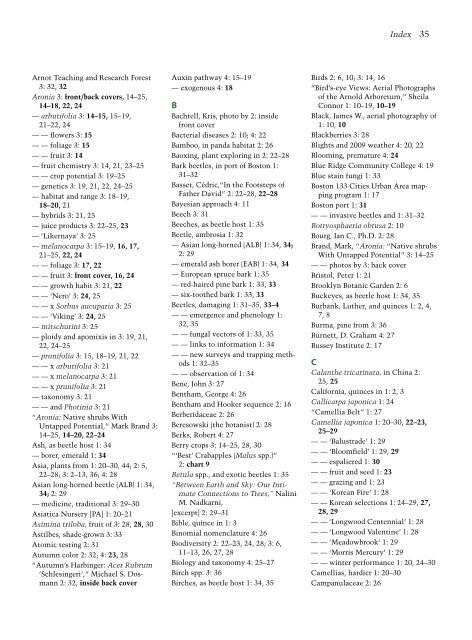The Magazine of the Arnold Arboretum - Arnoldia - Harvard University
The Magazine of the Arnold Arboretum - Arnoldia - Harvard University
The Magazine of the Arnold Arboretum - Arnoldia - Harvard University
You also want an ePaper? Increase the reach of your titles
YUMPU automatically turns print PDFs into web optimized ePapers that Google loves.
Index 35<br />
Arnot Teaching and Research Forest<br />
3: 32, 32<br />
Aronia 3: front/back covers, 14–25,<br />
14–18, 22, 24<br />
— arbutifolia 3: 14–15, 15–19,<br />
21–22, 24<br />
— — flowers 3: 15<br />
— — foliage 3: 15<br />
— — fruit 3: 14<br />
— fruit chemistry 3: 14, 21, 23–25<br />
— — crop potential 3: 19–25<br />
— genetics 3: 19, 21, 22, 24–25<br />
— habitat and range 3: 18–19,<br />
18–20, 21<br />
— hybrids 3: 21, 25<br />
— juice products 3: 22–25, 23<br />
— ‘Likernaya’ 3: 25<br />
— melanocarpa 3: 15–19, 16, 17,<br />
21–25, 22, 24<br />
— — foliage 3: 17, 22<br />
— — fruit 3: front cover, 16, 24<br />
— — growth habit 3: 21, 22<br />
— — ‘Nero’ 3: 24, 25<br />
— — x Sorbus aucuparia 3: 25<br />
— — ‘Viking’ 3: 24, 25<br />
— mitschurini 3: 25<br />
— ploidy and apomixis in 3: 19, 21,<br />
22, 24–25<br />
— prunifolia 3: 15, 18–19, 21, 22<br />
— — x arbutifolia 3: 21<br />
— — x melanocarpa 3: 21<br />
— — x prunifolia 3: 21<br />
— taxonomy 3: 21<br />
— — and Photinia 3: 21<br />
“Aronia: Native shrubs With<br />
Untapped Potential,” Mark Brand 3:<br />
14–25, 14–20, 22–24<br />
Ash, as beetle host 1: 34<br />
— borer, emerald 1: 34<br />
Asia, plants from 1: 20–30, 44; 2: 5,<br />
22–28; 3: 2–13, 36; 4: 28<br />
Asian long-horned beetle (ALB) 1: 34,<br />
34; 2: 29<br />
— medicine, traditional 3: 29–30<br />
Asiatica Nursery [PA] 1: 20–21<br />
Asimina triloba, fruit <strong>of</strong> 3: 28, 28, 30<br />
Astilbes, shade-grown 3: 33<br />
Atomic testing 2: 31<br />
Autumn color 2: 32; 4: 23, 28<br />
“Autumn’s Harbinger: Acer Rubrum<br />
‘Schlesingeri’,” Michael S. Dosmann<br />
2: 32, inside back cover<br />
Auxin pathway 4: 15–19<br />
— exogenous 4: 18<br />
B<br />
Bachtell, Kris, photo by 2: inside<br />
front cover<br />
Bacterial diseases 2: 10; 4: 22<br />
Bamboo, in panda habitat 2: 26<br />
Baoxing, plant exploring in 2: 22–28<br />
Bark beetles, in port <strong>of</strong> Boston 1:<br />
31–32<br />
Basset, Cédric,“In <strong>the</strong> Footsteps <strong>of</strong><br />
Fa<strong>the</strong>r David” 2: 22–28, 22–28<br />
Bayesian approach 4: 11<br />
Beech 3: 31<br />
Beeches, as beetle host 1: 35<br />
Beetle, ambrosia 1: 32<br />
— Asian long-horned (ALB) 1: 34, 34;<br />
2: 29<br />
— emerald ash borer (EAB) 1: 34, 34<br />
— European spruce bark 1: 35<br />
— red-haired pine bark 1: 33, 33<br />
— six-too<strong>the</strong>d bark 1: 33, 33<br />
Beetles, damaging 1: 31–35, 33–4<br />
— — emergence and phenology 1:<br />
32, 35<br />
— — fungal vectors <strong>of</strong> 1: 33, 35<br />
— — links to information 1: 34<br />
— — new surveys and trapping methods<br />
1: 32–35<br />
— — observation <strong>of</strong> 1: 34<br />
Bene, John 3: 27<br />
Bentham, George 4: 26<br />
Bentham and Hooker sequence 2: 16<br />
Berberidaceae 2: 26<br />
Beresowski (<strong>the</strong> botanist) 2: 28<br />
Berks, Robert 4: 27<br />
Berry crops 3: 14–25, 28, 30<br />
“‘Best’ Crabapples (Malus spp.)”<br />
2: chart 9<br />
Betula spp., and exotic beetles 1: 35<br />
“Between Earth and Sky: Our Intimate<br />
Connections to Trees,” Nalini<br />
M. Nadkarni,<br />
[excerpt] 2: 29–31<br />
Bible, quince in 1: 3<br />
Binomial nomenclature 4: 26<br />
Biodiversity 2: 22–23, 24, 28; 3: 6,<br />
11–13, 26, 27, 28<br />
Biology and taxonomy 4: 25–27<br />
Birch spp. 3: 36<br />
Birches, as beetle host 1: 34, 35<br />
Birds 2: 6, 10; 3: 14, 16<br />
“Bird’s-eye Views: Aerial Photographs<br />
<strong>of</strong> <strong>the</strong> <strong>Arnold</strong> <strong>Arboretum</strong>,” Sheila<br />
Connor 1: 10–19, 10–19<br />
Black, James W., aerial photography <strong>of</strong><br />
1: 10, 10<br />
Blackberries 3: 28<br />
Blights and 2009 wea<strong>the</strong>r 4: 20, 22<br />
Blooming, premature 4: 24<br />
Blue Ridge Community College 4: 19<br />
Blue stain fungi 1: 33<br />
Boston 133 Cities Urban Area mapping<br />
program 1: 17<br />
Boston port 1: 31<br />
— — invasive beetles and 1: 31–32<br />
Botryosphaeria obtusa 2: 10<br />
Bourg, Ian C., Ph.D. 2: 28<br />
Brand, Mark, “Aronia: “Native shrubs<br />
With Untapped Potential” 3: 14–25<br />
— — photos by 3: back cover<br />
Bristol, Peter 1: 21<br />
Brooklyn Botanic Garden 2: 6<br />
Buckeyes, as beetle host 1: 34, 35<br />
Burbank, Lu<strong>the</strong>r, and quinces 1: 2, 4,<br />
7, 8<br />
Burma, pine from 3: 36<br />
Burnett, D. Graham 4: 27<br />
Bussey Institute 2: 17<br />
C<br />
Calan<strong>the</strong> tricarinata, in China 2:<br />
25, 25<br />
California, quinces in 1: 2, 3<br />
Callicarpa japonica 1: 24<br />
“Camellia Belt” 1: 27<br />
Camellia japonica 1: 20–30, 22–23,<br />
25–29<br />
— — ‘Balustrade’ 1: 29<br />
— — ‘Bloomfield’ 1: 29, 29<br />
— — espaliered 1: 30<br />
— — fruit and seed 1: 23<br />
— — grazing and 1: 23<br />
— — ‘Korean Fire’ 1: 28<br />
— — Korean selections 1: 24–29, 27,<br />
28, 29<br />
— — ‘Longwood Centennial’ 1: 28<br />
— — ‘Longwood Valentine’ 1: 28<br />
— — ‘Meadowbrook’ 1: 29<br />
— — ‘Morris Mercury’ 1: 29<br />
— — winter performance 1: 20, 24–30<br />
Camellias, hardier 1: 20–30<br />
Campanulaceae 2: 26

















